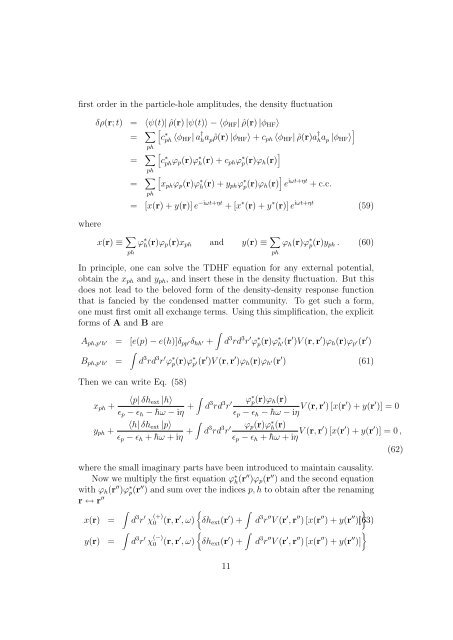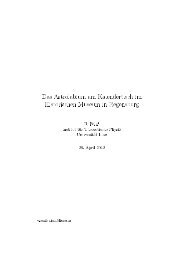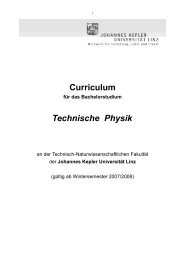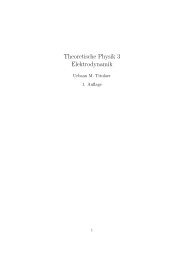Linear response and Time dependent Hartree-Fock
Linear response and Time dependent Hartree-Fock
Linear response and Time dependent Hartree-Fock
Create successful ePaper yourself
Turn your PDF publications into a flip-book with our unique Google optimized e-Paper software.
first order in the particle-hole amplitudes, the density fluctuation<br />
δρ(r; t) = 〈ψ(t)| ˆρ(r) |ψ(t)〉 − 〈φ HF | ˆρ(r) |φ HF 〉<br />
[<br />
c<br />
∗<br />
ph 〈φ HF | a † h a p ˆρ(r) |φ HF 〉 + c ph 〈φ HF | ˆρ(r)a † h a p |φ HF 〉 ]<br />
= ∑ ph<br />
= ∑ ph<br />
[<br />
c<br />
∗<br />
ph ϕ p (r)ϕ ∗ h(r) + c ph ϕ ∗ p(r)ϕ h (r) ]<br />
= ∑ ph<br />
[<br />
xph ϕ p (r)ϕ ∗ h(r) + y ph ϕ ∗ p(r)ϕ h (r) ] e iωt+ηt + c.c.<br />
where<br />
= [x(r) + y(r)] e −iωt+ηt + [x ∗ (r) + y ∗ (r)] e iωt+ηt (59)<br />
x(r) ≡ ∑ ph<br />
ϕ ∗ h(r)ϕ p (r)x ph <strong>and</strong> y(r) ≡ ∑ ph<br />
ϕ h (r)ϕ ∗ p(r)y ph . (60)<br />
In principle, one can solve the TDHF equation for any external potential,<br />
obtain the x ph <strong>and</strong> y ph , <strong>and</strong> insert these in the density fluctuation. But this<br />
does not lead to the beloved form of the density-density <strong>response</strong> function<br />
that is fancied by the condensed matter community. To get such a form,<br />
one must first omit all exchange terms. Using this simplification, the explicit<br />
forms of A <strong>and</strong> B are<br />
∫<br />
A ph,p ′ h ′ = [e(p) − e(h)]δ pp ′δ hh ′ + d 3 rd 3 r ′ ϕ ∗ p(r)ϕ ∗ h ′(r′ )V (r, r ′ )ϕ h (r)ϕ p ′(r ′ )<br />
∫<br />
B ph,p ′ h ′ = d 3 rd 3 r ′ ϕ ∗ p(r)ϕ ∗ p ′(r′ )V (r, r ′ )ϕ h (r)ϕ h ′(r ′ ) (61)<br />
Then we can write Eq. (58)<br />
x ph +<br />
y ph +<br />
∫<br />
〈p| δh ext |h〉<br />
ɛ p − ɛ h − ¯hω − iη + ∫<br />
〈h| δh ext |p〉<br />
ɛ p − ɛ h + ¯hω + iη +<br />
d 3 rd 3 r ′ ϕ ∗ p(r)ϕ h (r)<br />
ɛ p − ɛ h − ¯hω − iη V (r, r′ ) [x(r ′ ) + y(r ′ )] = 0<br />
d 3 rd 3 r ′ ϕ p (r)ϕ ∗ h(r)<br />
ɛ p − ɛ h + ¯hω + iη V (r, r′ ) [x(r ′ ) + y(r ′ )] = 0 ,<br />
where the small imaginary parts have been introduced to maintain causality.<br />
Now we multiply the first equation ϕ ∗ h(r ′′ )ϕ p (r ′′ ) <strong>and</strong> the second equation<br />
with ϕ h (r ′′ )ϕ ∗ p(r ′′ ) <strong>and</strong> sum over the indices p, h to obtain after the renaming<br />
r ↔ r ′′<br />
x(r) =<br />
y(r) =<br />
∫<br />
∫<br />
d 3 r ′ χ (+)<br />
{<br />
0 (r, r ′ , ω)<br />
d 3 r ′ χ (−)<br />
0 (r, r ′ , ω)<br />
∫<br />
δh ext (r ′ ) +<br />
{<br />
∫<br />
δh ext (r ′ ) +<br />
11<br />
}<br />
d 3 r ′′ V (r ′ , r ′′ ) [x(r ′′ ) + y(r ′′ )] (63)<br />
}<br />
d 3 r ′′ V (r ′ , r ′′ ) [x(r ′′ ) + y(r ′′ )]<br />
(62)












